#manucripts
Explore tagged Tumblr posts
Text
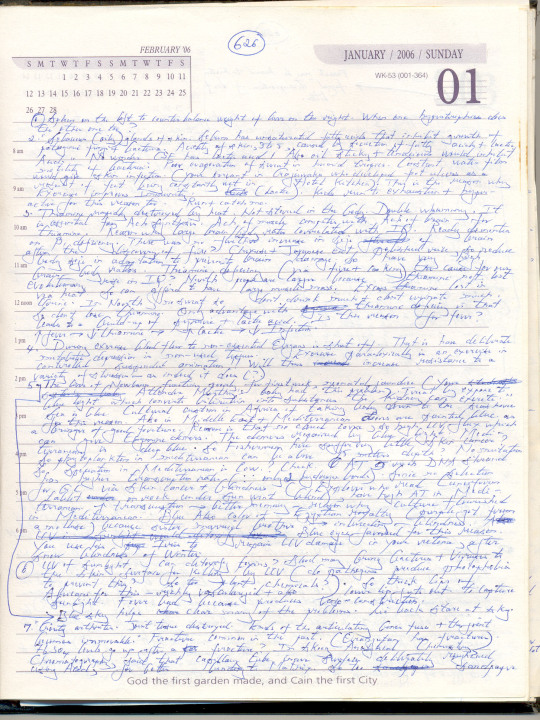
TSRNOSS, p 626.
#spleen#sebaceous glands#thiamine#liver of newborn#exercise#blindness#ultraviolet light#gouty arthritis#orangutan#manucripts#calligraphy#handwriting
0 notes
Text
Ok so. I am writing and illustrating a novel called ‘Ynys Arawyn’.
It is structured as such:
Prose Chapter | Riddle | Poetry Chapter | Prose Chapter, repeat. It has illustrations throughout and I’m aiming for a medieval book of hours type thing.
It contains fictional fantasy retellings of the history of Merthyr Tydfil and the Ironmasters, the brutal history of Abergavenny Castle, and many more tales sown into the heart of South Wales. It takes inspiration from the works of Shakespeare (in dialect), Tolkien (in vibe) and Welsh History and Mythology.
There are soliloquys, LGBT+ themes, nurturing nature, brutal betrayals, a fight between two magic wielding brothers, sieges, battles of wits, giantess warrior witches, dragons, magical conduits, elves (Tylwyth Teg), fallen stars, werewolves (cwn annwn and Y Helais-Wyllt), ghouls (wrach’ribn), and half-spider monstrosities.
Beware ye, all who enter - here be monsters. Monsters, and men. But which is which? What makes a monster a monster? Can a man become a monster become a man?
It is deeply druidic, wholeheartedly Cymraeg, and very very queer.
Chapter titles are in Welsh, although I am also playing with linguistics to create my own language.
The language of the Coronids - stars, created by and sparkling like dew in the web of the Void Spider Coronach - is written in the round, like the manucript for ‘En La Maison Dedalus’, punctuated with long sweeping lines connecting the phrases, resulting in writing that spirals and connects like a spider’s web. The language itself is a mixture of Gaulish, Cymraeg and Kernowek (I lived in Cornwall for a while), and the language that the elves use is derived from this - given that they studied the stars from the mountaintops - and is pretty much just a more phonetic Cymraeg, and written in linear lines. There are hardly any speakers of the language, since it is mostly used for incantations and spells, and not many elves in the modern day were taught to wield the power of the mountains. But the language is reviving itself.
So far, I’ve written many poems, a couple of chapters and a collection of riddles, some in English and one in my Tylwyth Language (with a translation). I’ve drawn a rough map. I’ve designed the spiralling format of the original Coronid scripture. It’s starting to come together.
I’ve not marketed it yet, nor have I disclosed any of it up until now, as it’s still a work in progress, but if you love the following, I’m confident you’ll enjoy it!
🍎 LGBT themes - main characters!!
🍎 D&D, BG3, The Witcher, Dragon Age
🍎 Tolkien
🍎 Welsh Mythology and Folklore
🍎 Dark, Gritty but Beautiful Fantasy
🍎 Shakespeare
🍎 Linguistics, particularly for ancient languages
🍎 Welsh History
🍎 Enemies to Lovers
🍎 Strong female characters who aren’t “girlbosses”.
🍎 Sad old men
🍎 Lady Knights, Celestial Femboys and Transmasc Monsters, Oh My!
🍎 Riverdance
If it was ever made into a film or series, I’d want this as the theme tune!!!
I’m also looking to get it translated and published in Welsh. Ideally, I’m hoping to work with Y Lolfa. My dream is to make it to the Hay Festival and the National Eisteddfod, where I someday hope to compete as a Bard.
A sample of my art:




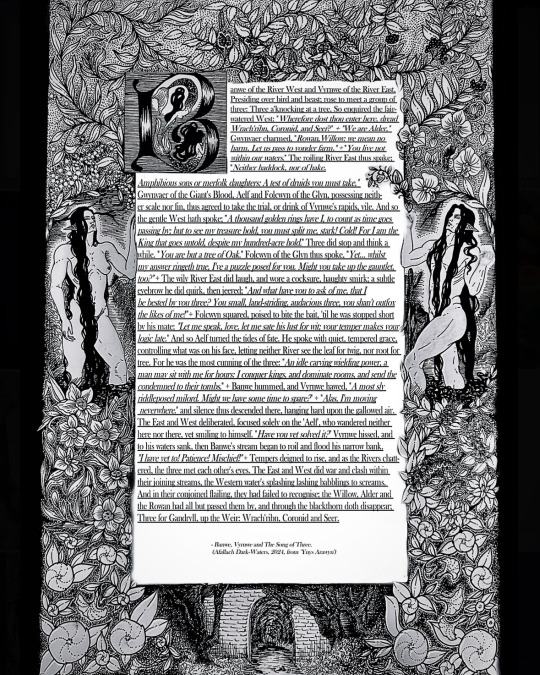
#silmarillion#silm#the silm#the silmarillion#lotr#welsh druid#welsh culture#welsh folklore#welsh mythology#lgbtq community#lgbt pride#lgbtq#lgbtqia#lgbtq positivity#fantasy writer#fantasy#fantasy writers#writers on tumblr#writing#SoundCloud
13 notes
·
View notes
Photo

65 notes
·
View notes
Photo

Luke
10th c. Gospelbook, Oxford, Bodleian Library, Auct D.2.16, f.101v from Landevennec, Brittany
59 notes
·
View notes
Note
Do you have the entire comic/storyboards planned out in advance or do you make them when you decide to start working on updates?
Short answer; yes and no, but it depends on the release.
I start by writing a manucript, then I storyboard. The storyboards for the entirety of book 1 were all made before chapter 1 was inked and coloured, so they are quite old and don't fit my current standards for how pages should be laid out. So I end up making new ones anyway using the originals as a guide. Thankfully for me, the more I worked on the OG storyboards the more I got a better feel for how panels should work, so I hope that the closer I get to the end of book 1, the less redrawing I'll have to do.
But since I started publishing, I've actually gone back and ADDED scenes to the manuscript, which means there are no pre-existing storyboards for those. So I just have to make shit up when it's time to draw them.
#book 1 has six chapters but with all the additions it feels like twelve#explodes n dies#inquiries#no one prepares you for the chaos of comic making tbh
7 notes
·
View notes
Note
📓 :D
THANK YOU
im so happy sharing these ideas lmao thank you to everyone whos sending me something i love it
fic idea number 174729: zukka
sokka is a movie director. he is precise in his execution and his films are brilliant. oscar winning. sokka is a big deal. sokka is also constantly stressed out of his mind. he loves his job, he really does. but none of the goddamn writers in this town are any good anymore. every new script he recieves is either poorly written with a good premise that sokka has to do numerous edits on with the writers until its worth something or just complete and utter garbage that cant be saved.
enter zuko.
zuko has been trying to get someone to read his scripts for ages. but its hard to break into the business unless you know someone. one night while drinking in a bar, he meets this girl katara and becomes fast friends with her and her boyfriend aang. they ask him what he does and he mentions that he wants to be a screenwriter, but no one will give him a chance because hes a literal nobody.
aang and katara are like oh wow thats so interesting! can we read ur manuscript?
zuko is a bit wary to share his script with someone else, because this is LA. who knows if these two will try and steal his idea from him.
but theres something about kataras knowing smile and aangs excited eyes that make him think “sure why not”
they exchange numbers and emails and he lets them read the manucript.
three weeks later, katara calle zuko and asks if he wants to hang out. zuko is a little wary because they havent seen each other in person since that night at the bat but theyve been texting pretty regularly, as have he and aang, so he figures why not. itll be good for him to have friends in this town.
katara tells him to meet her at her apartment so they can leave together to meet up with aang somewhere.
when he shows up to meet katara shes not alone.
no. she is definitely not alone.
sokka, one of zukos favorite directors, is sitting right next to her on the couch.
apprantly hes her brother.
apparantly he loved zukos script.
apparantly it was the best writing he has seen in ages.
soon enough the two become one of the most renowned director/writer duos in hollywood. and one of the most iconic couples too.
#avatar the last airbender#atla#sokka#zuko#zukka#this is the good good#like dramatic theatre nerd zuko meets detail oriented director sokka? CMON PEOPLE#its about translating their characterizations in canon to real life jobs that makes me heart go bum bum#i wanna write this so bad man#will i ever have time? who knows...#send me an emoji and ill reply with a fic idea that i daydream aboit
27 notes
·
View notes
Note
jake in tumblrina further solidifies my evidences why jake is bitchless (sunoo my guy i pray for MORE long patience and braincells to deal with jake's unfiltered mouth) 🚪🏃♀ might as well conduct a research why jake is bitchless and put my rusty brain to work 🗿 gonna send u the manucript soon !!
also,,
SOOBIN 🗣‼️ SOOBIN 🗣‼️ MY MAN YOU ARE BEING DETHRONED GET YOUR CROWN BACK 🗣‼️ AND PROVE YOU HAVE THE UNHINGED MOUTH OF THEM ALL 💥💥
Y/N WHAT DOES IT FEELS LIKE TO BE HOONIE'S LITTLE HUMAN SPEAK TO THE MIC PLS 🎤💥🎤💥
naur not me having a mental image of hoon riding a motorbike (HE'S SO FUCKING HOT LANDKAOAO IMAGINE HE'S REMOVING THE HELMET THEN WINKING AT YOU JUST TO MAKE YOU FLUSTERED AND SHIT AND HE'LL SMILE AT YOU SHOWING HIS FANGY SMILE IN ITS FULL GLORY) LIKE BLS IVE HAD ENOUGH GOT ME PACING AROUND OUR KITCHEN TABLE TRYNG TO SHRUG OFF THE MENTAL IMAGE because if i were y/n i would probably faint on the spot my pea sized brain cannot comprehend this i might just kiss the demon infront of me
JKSGHDFJKGH HONESTLY WHAT IS GOING ON IN HIS MIND LATELY 😭 I hope Sunoo is coping well with the sudden change in demeanor 💀 (he's probably... he does live with him after all)
omg Soobin up your game soon!! Jake is literally speeding to get the crown from you where is the unfiltered Soobin we all know and love?? 🤕🤕 and Y/N is probably living her best life knowing the feelings are mutual even if they haven't had a proper convo yet LOL
STOPP THAT IS SO???? 🥵 his hair all ruffled from taking of the helmet WHILE smirking... I'm gonna pass out rn. Bet he had to get Y/N a helmet in her fave color or maybe something that matches Y/N;s personality LMFAOOO like imagines the contrast from his sleek black helmet ✋🏼😭
3 notes
·
View notes
Text
As an author, the most important question you need to ask yourself constantly is, “Why do you write?” For me, I write the same reason I read; to answer questions you don’t want to experience first hand. Walk two moons in someone else’s moccasins. Explore a path that scares you before you take it. Try something you’ve always want to by opening your heart and letting your imagination do the teaching.
By doing that, I think that as a society we can learn how to take hold of life and explore so much more than what is possible with our hands and our feet.
As a poster on my childhoods school library always told me, “A reader lives a thousand lifetimes, where someone who does not only lives one.”
It’s a little cheesy, I know. Yet maybe there’s something we can learn from it.
#writing#question#response#wip#my writing#manucript#dream#idea#not an official author just yet#showerthoughts
0 notes
Text
I am planning on finishing my third draft of Whims and Wishes next weekend and....would maybe like a CP for feedback?
If anyone wants a critique partner (where we swap manucripts and provide feedback) message me!
I'll read YA anything, especially fantasy / sci fi. my wip is here (YA High Fantasy)
2 notes
·
View notes
Text
20/3/2020 (Lecture 3)
Following week 2′s lecture about the earliest systems of recorded language, we found that similarly to Hieroglyphics, a mix of pictograms and ideograms can be found in Chinese characters. As seen as the picture below, the letter-forms are seen to be closely related to natural elements such as the bamboo stalks.
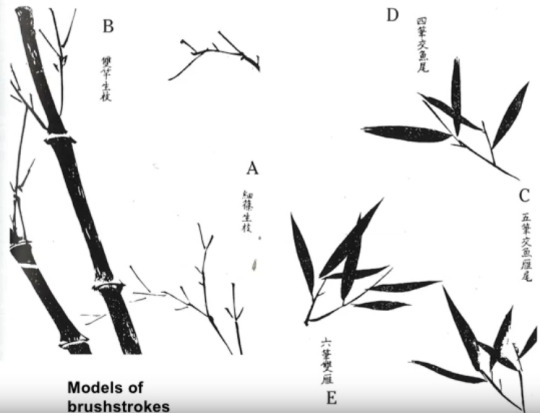
Furthermore, Japanese letter-forms are shown to also demonstrate its relationship to natural elements. As seen in the image below of an ancient manuscript which reads, ‘the waves of the river never stop, and yet it is never the same water’ which matches the mode of inscriptions fluidity, and the ways of which the characters flow together from top to bottom, similar to a river.
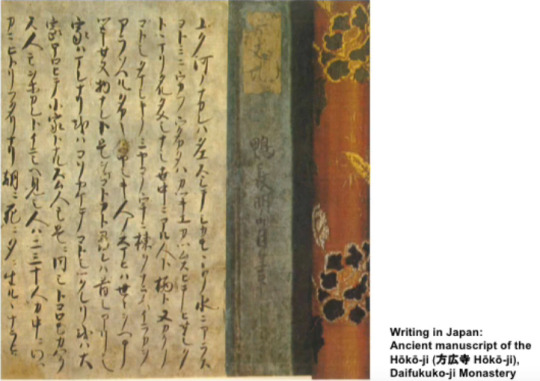
Additionally, I find it interesting that the alignment of characters can be manipulated to create an image, such that is seen below. This also changing the way it is read, which in this case is from inside to out. Ultimately, i have learnt that the arrangement of letters can demonstrate or form meaning. This being shown in the Khmer manucripts, and Ancient manuscript of the Hoko-ji, Daifukuko-ji Monastery.
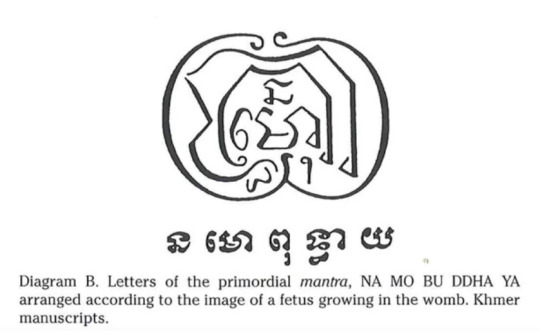
Overall, it was interesting to find that many letter-forms are derived and inspired from natural elements. Meanings being able to be demonstrated through it’s arrangement, such as how it is read and shaped.
1 note
·
View note
Note
honestly I can’t wait to read your thesis. I sounds like such an interesting theme!!
djfdslfjsl anon that goes right to my heart!! if you come off anon around august 2021 i should be able to send you a manucript, hopefully :)
1 note
·
View note
Text
Of The Shrine, The Tools And The Vestments
FOURTH TEXT OF THE TORCHIAN MANUSCRIPT
The Demons Worked with within the Rites and Arts of The Torchian Manucript have been revealed and not we must examine the erection of the Shrine of Satan and detail the Ritual Tools and Vestments required for the Workings that shall be carried out before it. In truth within Satanic Cabals there will be Instruments of Magick that will be found in all and other items that will only be found in specific Covens depending on the type of Ritual format the particular Group adopts. The same applies to individual Practitioners of the Black Arts . . . what is relayed here is the setting up of the Ritual Shrine of Satan and in accordance with the system of Magick worked with within The Torchian Manuscript. There are certain Implements not included in the list below such as the severed hand of a man to forge The Hand Of Glory, the Staff Of The Seer and the animal heart required for The Thorns And The Heart Hex . . . such Implement are required only in these specific Rites as are others and so listing them all would be a little futile. Items such as these required for only one specific Workings shall be detailed within the text dealing with that Working.
SETTING UP THE SHRINE When setting up the Shrine Of Satan prior to Ritual and Magickal Workings the item being used for the Shrine/Altar should be covered with the Traditional Satanic Black Altar Cloth. Three Candle Holders should be upon the Shrine, one at either end for illumination purposes and one at the center which is lit in Devotion and Supplication of Satan . . . they should all hold Candles ready (Black, Red or Ivory are the only acceptable colours), the two illumination Candles should be lit prior to the Workings starting but not the Satanic Devoitional Candle. Other Instruments that should be set out on the Altar are listed below.
RITUAL IMPLEMENTS THE SATANIC SEAL This should be forged on Parchment Card and placed at the center of the Altar, it bears the Inverted Pentagram sacred to Satanism and at its center The Seal Of The Unholy Trinity which shall be explained later. THE CANDLE SNUFFER An implement for the extinguishing of all Ritual Candles. SATANIC GRIMOIRE A blank leaved Book which should contain the handwritten Rites and Magickal Arts the Satanist shall be working with. METAL ALTAR DISH OR BOWL This shall be used for the burning of materials within Rites. INCENSE/OIL BURNER For the burning of Rituals aromatics within Rites. SCRYING TOOL A Black Mirror, Obsidian Stone, Crystal Ball, Pyromancy Candle or some other Tool for Seership is useful to have upon the Altar, not just for Workings appertaining to these Arts but in case the need arises to consult such an Implement during Rites. OTHER MAGICKAL IMPLEMENTS CHARCOAL DISCS These will only be needed if the Satanist is using loose Incense for their Ritual aromatics. CANDLES A healthy stock of Candles should be kept ready at all times for Altar use and illumination of the Ritual area. PARCHMENT CARD AND PARCHMENT PAPER As with the Candles Parchment Card and Paper should be available to the Satanist for use in making Sigils, Seals, Oaths, Pacts and Markers among other items. INCENSES AND OILS For the Satanist utilizing Ritual aromatics a stock of Oils/Incenses shall also need to be maintained. Cinnamon, Sandalwood, Pine, Sulfur, Tobacco or Mint are best used. CRYSTAL PENDULUM Another useful Tool to be used in the Arts of Divining, in Location Workings etc - the Crystal should be either Obsidian, Jet, Clear Quartz, Smoky Quartz or Black Tourmaline. SCRYING JOURNAL A blank leaved journal should be kept by the Satanist to note down messages, symbols, words and other communications gained during Scrying Practices. PEN For the writing of notes within the Scrying Journal . . . it should be noted that pens, inscribing or engraving tools etc that are used in Ritual should only be used in Ritual.
THE RITUAL VESTMENTS The Traditional Ritual Vestment of the Satanist is either a hooded robe or cloak which is usually Black but on occasion Red depending on individual choice, but Blac is always preferable. In the even of such a vestment not being available then the wearing of suitable Black clothing is an alternative option, but this should not be accepted as a first choice.
These are the main Implements/Tools/Vestments required for the Workings held within The Torchian Manuscript, as aforementioned there are others less used but these shall be dealt with in detail later in this Book.
(c)copyright Torchian 2018
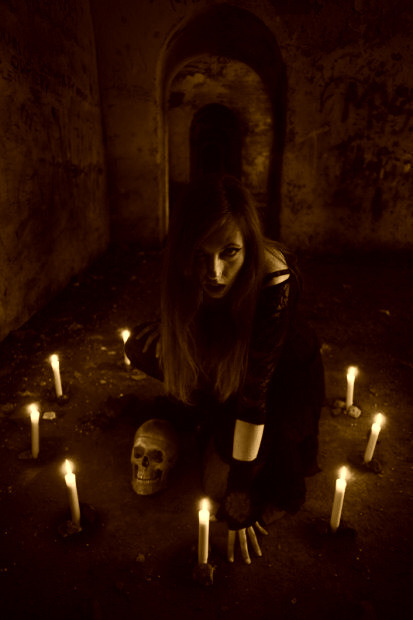
Original source of image is unknown - my edits!
50 notes
·
View notes
Text
On Writing, Planning and Process
The choice of approach to drafting your manuscript is one that can only be made confidently through experience. For those starting out, it can be seriously overwhelming. Write four drafts, says one author; write a plot and then draft, says another. Just plough straight in, call a few more from the back. All in all, a newbie writer would probably wind up approaching their story like this:

At the end of the day, only you can discover your process as you start to write—however, for those starting, here are some places for you to begin. Heck, even if you're an experienced writer, it can be good to remember the basics and how flexible they are!
Hang on Art, what does "the writing process" actually mean?
The process of writing is broken up into lots of stages—you have editing, drafting, revisions, beta-reading rounds... It's a smorgasbord, and an overwhelming one. I attempted to flow-chart it and got pretty flummoxed.
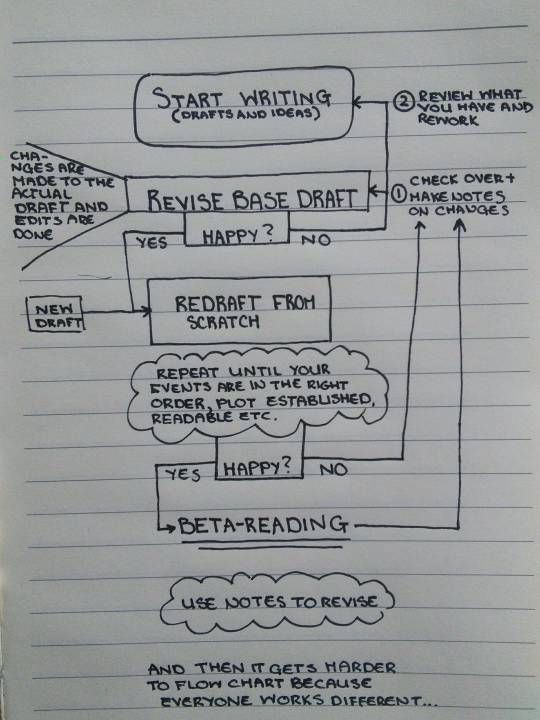
Thing is, there is no set process. The drafts and revisions are mainly intuitive, because you kinda have to do them—it's hard to edit a several hundred page story without doing that. My approach is more chaotic than this one, but I still get books written because it works for me.
Some of the possible approaches to drafting are:
Plot first – make a plot, outlines, chronology—the works. Doing this first means you could then plunge straight into draft one, if you wanted to.
Draft zero – this is the stuff you have at first, before any real plot or concrete concepts. It's worldbuilding, character development, moodboards... All the fun bits. Some people merge this with draft 0.5, and others skip it altogether. Sometimes it involves plotting, sometimes not.
It's really just the pre-story phase of spitballing, caffeine and stress.
Draft 0.5 – this is my preferred starting point, but it isn't for everyone. It's a manuscript, and it's got scenes in some kind of chronology, but it's also awful and impossible for anyone to read. Scenes are in the wrong places, features keep on appearing and disappearing, and entire characters are missing. The point is to get something on a page, and see where it goes. My own draft 0.5 for of Seas and Stars got re-started no less than fifteen times, each one vastly different from the last until I came to what I have now, which I am halfway through.
Plotting interval – for some, the plot comes first. For others, you figure out a basic one partway through draft 0.5 and run with it, making alterations along the way, or you sort it out later once draft 0.5 is done. If your plot is character driven, you may want to really get to know your characters all the way up to the first draft, and then make your plot while doing the second draft. If your plot is story-driven, you might make an outline as the very first thing you do.
Stephen King used the beautiful metaphor of finding a plot being like delecately excavating a large fossil, and while I think that metaphor is exactly what the writing process is like, there would also need to be some sort of plan in place before the excavation began. That is to say, although he intended the metaphor as a warning against plotting beforehand, it could be interpreted differently and still be very valid advice.
Rinse, Repeat - draft one acts as a stable(ish) base. From there onwards, you can break and rebuild as much as you like; the important thing is that you know what the fossil is, even if all of the bones are in the wrong place and need extensive repairs.
Once you’ve got the fossil manucript in a readable format, with the events as you want them, characters where they should be and the world established, you should start to consider beta-reading. It isn’t the end of the writing process, but it certainly helps you to get there. Your fossil has been assembled and the missing chunks filled in; all that is left now is to send off to the science guys who do their analysis so you can ready the fossil for museum display!
(Art, that’s enough about the fossil. Just talk about beta-reading already)
Your beta-readers act as a proto-audience, of sorts; except, they actually give you their feedback and are usually pretty harsh, rather than chatting about your writing at a book club where you will never hear the comments. 10-20 tends to be the range of beta-readers used. I like to aim for fifteen, max, but I have seen calls out in the past for 25.
Their input is so very, very valuable, even though it can be hard not to take it personally. I talked about my own discoveries about the beta process and how to survive it recently, here. Deciding when to put out the call for beta readers depends on how you feel, and whether or not you think it will help your story at the stage it is in. Working on my short story, The Circularity of Devolution, I found it helpful to share the story in its second draft and use the beta-reader’s comments as notes when revising and redrafting. However, I know that of Seas and Stars will still be unreadable by the second draft, and so won’t want beta readers for that.
Full disclosure: although an experienced writer, I only had my first taste of beta readers recently, and so although I can say a lot about how I personally found it, I’m not much good at providing a more objective view. But you know who can? @brynwrites. They have this ask here summarising a few pointers, and then this FAQ on beta-readers. There’s more if you browse for it, but these are the key things you might need to know.
But do you need to do all of this in one go?
No, not at all. Again, it’s completely up to you, although I wouldn’t reccomend doing that for a few reasons:
You could burn out and kill a great story
Breaks help you gain perspective
You have a life outside of writing, and you need to be there for that too
writing is mentally, physically and emotionally demanding
working on one thing continuously could kill inspiration
As Bryn says, beta-reading rounds are great times to take a break and work on something else. I intend to use mine to type up a fanfic I’m handwriting. As well as talking about manuscripts being like fossils, Stephen King also says how he likes to leave his novels for at least a month before going into the final draft. He uses that time to write novellas. It can be tempting to forgo breaks and run with your inspiration until you’re completely frazzled, but that won’t get you anywhere in the long run. Take care of the author, and then you can take care of the story!
After all this, what next?
If you’re going for publishing, there are lots of ways to do that. Supposing that you don’t self-publish, you may get an agent, which could lead you to editors, and eventually a published work. Sometimes, you can sit back and just allow your book to inch towards publication, all of your work done. Oftentimes, you might get rejected and sent a slip saying “Great story! But X, Y and Z need tweaking in order for it to be sellable”. You would then need to judge that advice, mix in a tiny bit of salt, and dive into another revision before you try again.
All it takes to find out more about publication options in a quick Google and a scour through the top articles. Listen to what published authors say, and do a lot of research for yourself. Check writing forums and magazines for agents, making sure that your writing and their preferrences are compatible. Make a pros and cons chart of Self-Publishing vs not self publishing.
It’s really important to have all of your options on the table before you make your choice.
This has been a part of my “On writing” advice series, which is updated a few times a month and covers topics from writing genius characters to representing certain groups, elements of the craft, genres and everything in between. Check out The Art Forecast to see what’s coming up for March.
If you have any questions in the meanttime, send in an ask (I’m thrilled to have re-opened my inbox!), and best of luck to you all in your writing and your life x
#writeblr#writing#writing advice#beta reader#publishing#writing process#writers on writing#writers on tumblr
146 notes
·
View notes
Text
I'd build a preservative vault somewhere geologically stable, and fill it with artifacts and manucripts and relics.
The reason why I'd put stuff in the vault instead of just bringing them forward in time is so that they can be verified through carbon-dating.
if i were a time traveler i’d just go do anthropologist and historian shit all throughout history. get those pre-christian versions of the norse myths from various different places. learn about dead cultures and languages. be a bystander at major historical events and then record the info.
and i’d probably have a youtube channel where i hosted videos and then presented the research as i’m getting hunted down by the time cops
124 notes
·
View notes
Text
Journal of Medical Research and Health Education
Journal of Medical Research & Health Education is an open access, online, peer reviewed international journal with a primary objective to reach the health sciences professionals with genuine and reliable source of data on current research on medicine and health education.
The journal includes wide branches of Medicine such as surgery, internal medicine, cardiology, orthopedics, infectious diseases and HIV/AIDs, obstetrics and gynaecology, oncology, and neurology, immunology, anaesthesia, cardiovascular medicine, complementary medicine, dentistry and oral medicine, pathology, pharmacology and therapeutics, dermatology, respiratory medicine, rheumatology, drugs and medicines, ear, nose and throat/otolaryngology, emergency medicine, infectious diseases, neurology, nutrition and metabolism, obstetrics and gynaecology, endocrinology, gastroenterology, genetics, geriatric medicine, haematology, oncology, ophthalmology, paediatrics, psychiatry, radiology, renal medicine, pharmacognosy, sexual health, urology, epidemiology, ethnic studies, health policy, occupational health, medical education, legal and forensic medicine, environmental medicine and public health, medicine development and safety testing, drug legislation and safety.
Journal of Medical Research & Health Education offers the best platform for the researchers and scientists of Health Sciences. This scholarly journal is using Editorial Tracking System for online manuscript submissions, review and tracking. Editorial board members of Journal of Medical Research & Health Education are active and rapid in assigning minimum two independent reviewer’s, on approval followed by the editors decision.
Submit manucript at https://www.imedpub.com/submissions/medical-research-health-education.html or email attachment to [email protected]

0 notes
Text
youtube
Par ces temps de trouble et d'incertitudes, il nous faut nous rappeler certaines histoires miraculeuses de la Bible afin de raffermir notre foi.
Pour cela, je te propose une série de 6 méditations quotidiennes à partir du 22 mars sous le tittre Des miracles à se rappeler.
Veux-tu me rejoindre?
Du 22 au 27 mars 2020
Une courte méditation par jour
Une prière spéciale à faire
Un journal gratuit de prière à télécharger
+ Le manucript de la méditaion à la fin de la semaine
Inscris-toi ici pour tous les détails
https://landing.mailerlite.com/webforms/landing/k3x7u5
0 notes